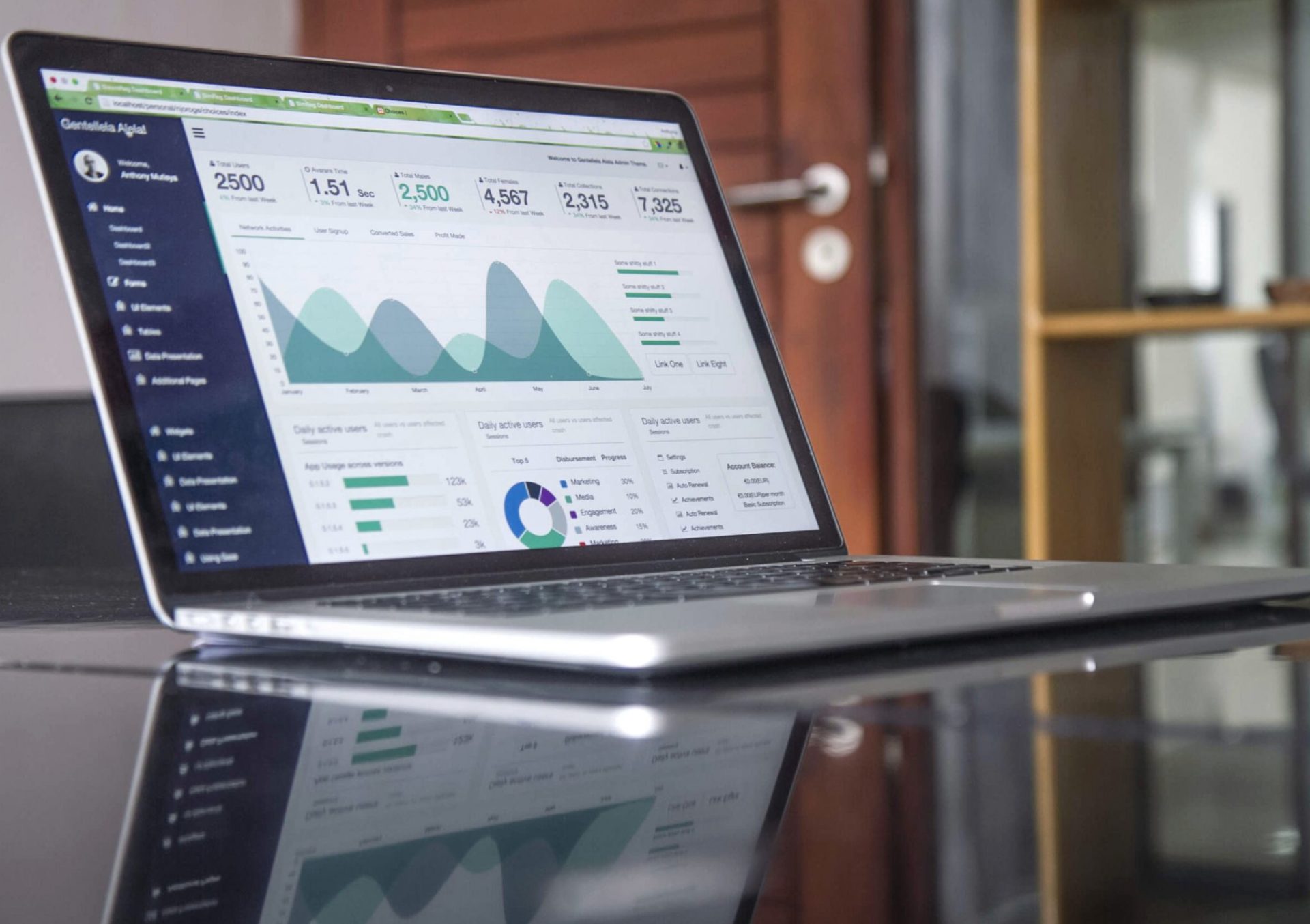Seth Godin is one of the few remaining marketers that sees the marketing mix as an art rather than a science. While reading his book “This is Marketing” I decided to revisit some of the fundamentals of marketing that get overlooked in today’s fast moving online space.
The marketing mix is a concept originally from the 1940’s that even today is featured in many academic materials. However it’s largely outdated and we can do better, making this more relevant for the 21st century.
- All The Marketing Mixes from 1940 – 2020 in one Infographic
- The Marketing Mix in 2 mins
- What is the Marketing Mix?
- Modern Marketing Mix in 2020 – The 7 C’s of Marketing
- Actionable Takeaways
All The Marketing Mixes from 1940 – 2020 in one Infographic
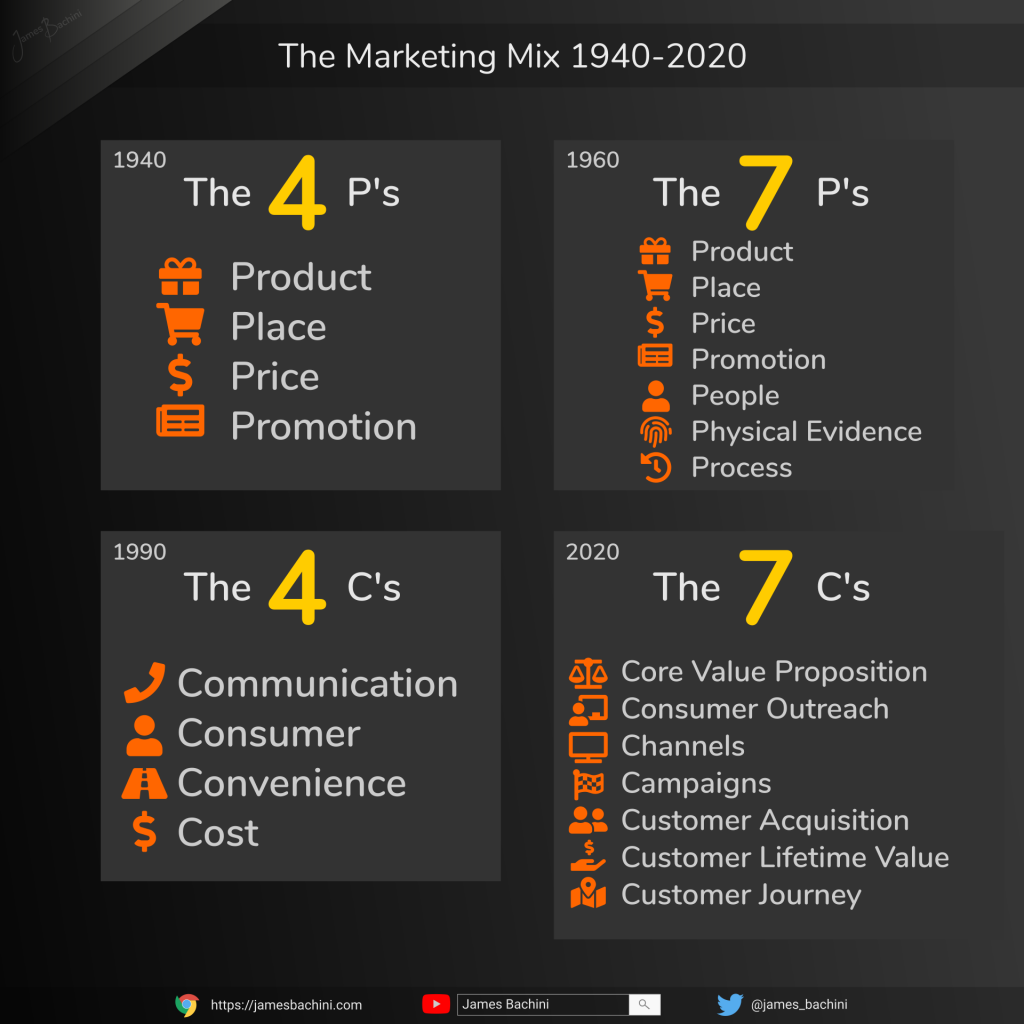
The Marketing Mix in 2 mins

What is the Marketing Mix?
The marketing mix was first used by James Culliton in the 1940’s and was originally the four P’s (Product, Place, Price, Promotion). Then in the 1960’s a marketing professor called Edmund Jerome McCarthy added another three, to make it more applicable to service industries. In the 1990’s the 4 C’s were introduced and today we have the 7’C’s which form the latest Marketing Mix.
We will go through these individually.
4 P’s of Marketing – Product, Place, Price, Promotion
Product – This is the product (or service) that your company sells. This needs to be an item that holds enough value in the eyes of consumers that they are willing to pay for it. Product development is the process of creating and bringing a product to market. A quality product makes every part of marketing and business easier and more efficient.
Place – Where will a product be sold? How will it reach the customers that want it? Place can be a physical location like a store or distribution network. E-commerce and online marketing are dominant in the 2020’s and platforms like Shopify make it easy to set up an online store in minutes.
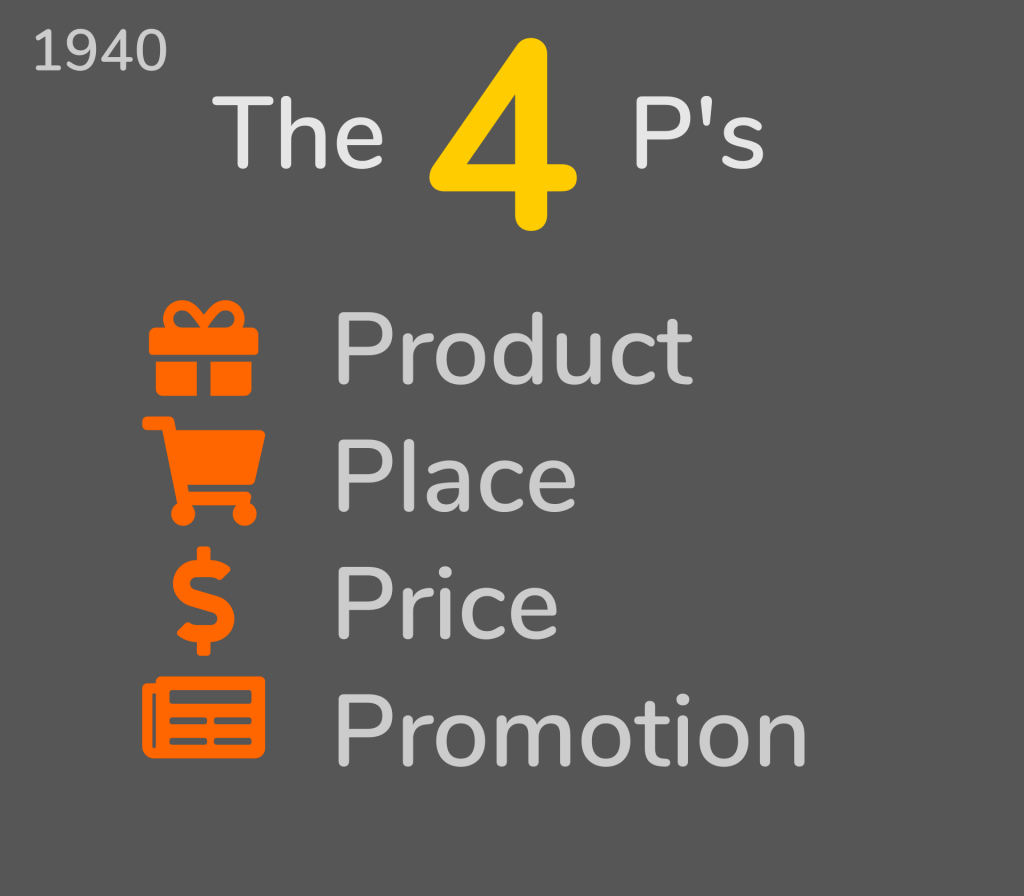
Price – We A/B test pricing strategies today because it’s as important as ever to find the optimal price of a product. Too low and the company is leaving money on the table, too high and the company loses revenue through missed sales opportunities. Perceived value plays a much larger role in pricing than product cost. Luxury brands such as Apple and Rolex can charge a premium based on how much their products are valued by a customer rather than what it costs to make.
Promotion – How will the company advertise to find customers? Even in the 1990’s “build it and they will come” didn’t work so well. A product needs to be promoted to gain initial traction. Promotions can be broken down into sales and marketing where sales is usually employed for high ticket price items and marketing is used across the entire price spectrum. Online marketing is the most effective form of promotion that the world has ever seen. As marketers we have the ability to reach and scale campaigns globally with targeting options that are as scary as they are effective.
7 P’s of Marketing – People, Physical Environment, Process
The 7 P’s of the marketing mix include the original four above plus the following
People – Management, employees, customers, stakeholders. Businesses are about people and organising personnel to carry out the functions of a company. Marketing is also about people, something online marketers are guilty of forgetting when we are knee deep in analytics and stats.
Physical Evidence – This is a concept that describes how we reassure our potential customers. As marketers how can we reduce fear, uncertainty and doubt in our sales process? Online marketers use customer reviews, testimonials, guarantees and security badges for this very reason.
Process – The marketing processes that a business makes between someone not knowing anything about the brand to becoming a full customer. Modern funnels are outlines of marketing processes that warm up leads and increase sales.
4 C’s of Marketing – Communication, Consumer, Convenience, Cost
In 1990 Bob Lauterborn wrote an article declaring the four P’s dead and that these 4 C’s were more useful to the marketing sector of the time. The four C’s of the marketing mix are actually as relevant today as they were in the late 20th century.
Communication – is how a consumer is made aware of a product. How does the business communicate with consumers and customers. Marketing is often a one-way form of communication where we tell people through websites and ads about our product. This is evolving however with things like chatbots and webinars opening up two way communication between the marketer and the consumer.
Consumer (wants and needs)– Who is the potential customer. Having a clear idea of the perfect customer goes a long way to planning out marketing campaigns. It’s very rare for products to appeal to an entire population and normally we can segment consumers by demographic, interest and behavioural targeting.
Convenience (to buy) – Consumers will generally follow the path of least resistance. This may mean shopping at a local store which is close to their home or it may mean using a site like Amazon because they already have one-click checkout enabled. Thinking about convenience throughout the customer journey can increase conversion rates and sales.
Cost (to satisfy) – The cost to sell an item and satisfy customer expectations. This forms the basis for margins if our products price point is higher than the cost involved in creating and distributing it. We could take this further today and work out our costs to satisfy alongside what it would take to exceed customer expectations.
Modern Marketing Mix in 2020 – The 7 C’s of Marketing
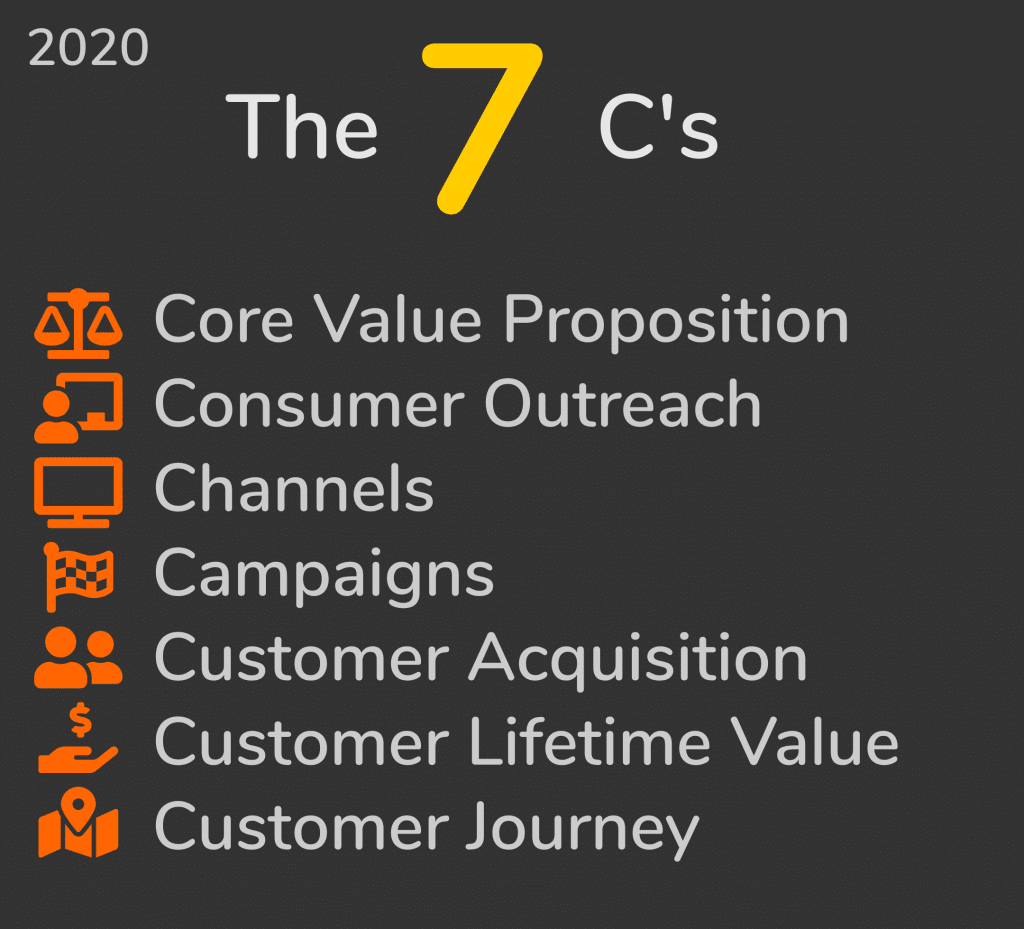
The 7 C’s of Modern Marketing are an updated take on the marketing mix which are highly relevant to online and offline businesses competing in today’s markets.
It starts, like all marketing, with a core value proposition.
Core Value Proposition
A core value proposition is a short statement that provides a compelling reason for a product to exist and why consumers should care.
It should explain the real problem that the product solves and how this benefits customers.
Value propositions are often aimed at selling the benefits rather than explaining a product. An example of this is Slack’s ”Be More Productive at Work with Less Effort”. That has broad appeal but doesn’t mention or give an indication of what the product actually is and how it works.
A product with a good value proposition will have an easier time finding “product/market fit”. This is a term used frequently by VC’s where consumers want what the company is offering. If a startup’s core value proposition is strong enough then communicating that proposition to consumers through marketing is easier. Sell shovels to miners.
Consumer Outreach
It’s no good having a great product if no one knows about it. While word spreads faster than ever before marketers still need to reach and engage potential customers. This may be for an initial launch period to create a seed audience or it may be a long-term customer acquisition strategy.
It’s critical to know who the ideal consumer is and how to reach them. The product will appeal to certain demographics more than others and researching this can provide insights into our marketing. Platforms such as YouTube, Google Ads and Facebook Ads all provide audience demographic and interest data which can be used to recalibrate our assumptions on who the product is for.
Once we know who our target consumers are we can think about where they spend their time, what websites/apps do they use, where do they shop? Most importantly how do they discover, research and purchase new products?
From there we can utilise marketing channels to create campaigns built to reach those consumers.
Channels
There are so many channels both online and offline where consumers can be reached and products can be sold. Here is a small sample of the major channels available to marketers today:-
| Online | Offline |
| Social media Advertising networks Mobile Apps YouTube | Shops and stores Markets Newspaper/Magazines Direct response mail Sales team |
Marketing channels and opportunities are not all created equally. Whenever a new channel becomes available to marketers there is normally a golden period where mainstream competition between advertisers is low while reach and engagement are high.
TikTok is a good example of this currently where the platform has relatively few advertisers but billions of impressions per day.
When thinking about channels it’s worth considering how the brand will be perceived through that particular channel. Branding is critical to bridging marketing channels and developing long term customers.
Campaigns
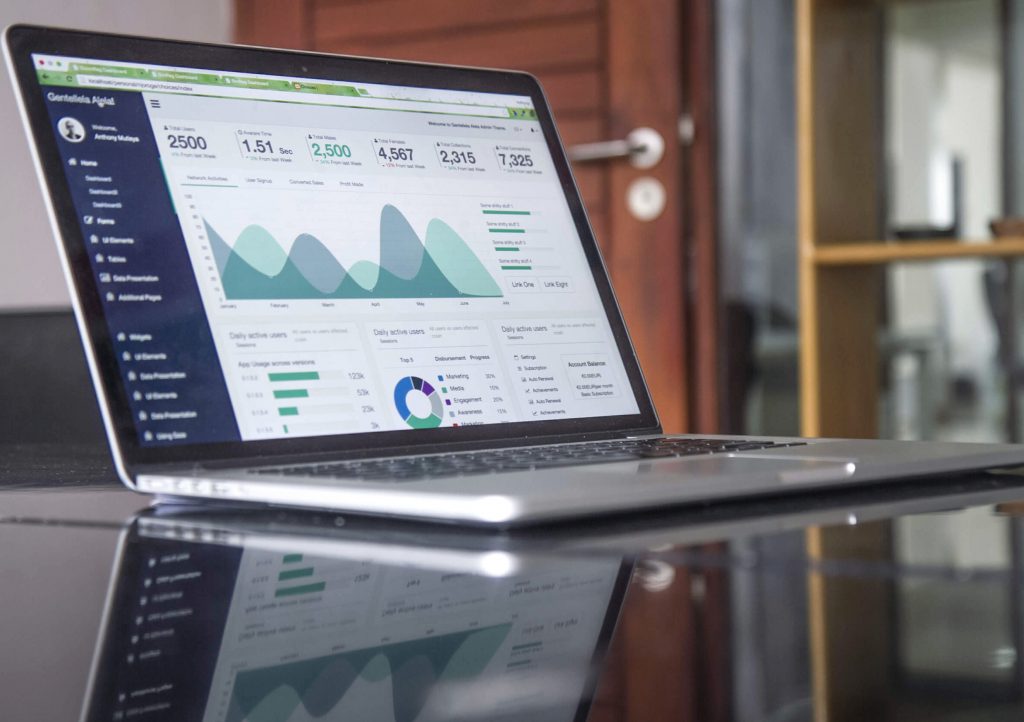
In the real world the marketing process is broken down into campaigns. A company may run multiple campaigns at anyone time and the exact definition will vary between businesses.
Marketing campaigns form containers in which we can test traffic sources, landing pages, promotions and products. Almost all ad networks are broken down at the top level by campaign.
For example an affiliate marketer may be promoting two different products on three different traffic sources in which case he would have six campaigns setup and monitor the return on ad spend (ROAS) for each independently.
Customer Acquisition
The cost of customer acquisition plays a big part in the scalability of many companies. If a product is selling for a price very close to its cost to manufacture then there is little margin left to market the product effectively and grow the business. However if perceived value is higher than actual value then this leaves a profitable margin which can be used to acquire new customers and grow a business exponentially.
Customer acquisition costs can be calculated via analytics platforms for direct response campaigns however this often doesn’t take into account repeat purchases and referrals from the new customer.
Let’s take a look at a dropshipping example where a marketer sells a product using facebook ads and then fulfills the order via AliExpress.
- Sales – $200
- Facebook Ads – $120
- Fulfillment – $60
- Profit – $20
You can see in this example that the product is selling at a high premium to it’s cost. Dropshippers generally purchase products in China and brand them to be sold in western markets to achieve the perceived value premium. The customer acquisition costs in this example are higher than the cost of the products so the consumer is effectively spending money on the marketing.
This is becoming more and more prevalent where the biggest companies are the ones that create the most perceived value and can spend the most to connect with more customers. This can be seen with Facebook and Google generating so much revenue from advertising that they are now some of the largest companies in the world.
A modern lean approach to marketing will often calculate customer acquisition costs through test campaigns prior to building a new product or service.
Customer Lifetime Value
Where previous marketing mixes have focused on price and cost it is more relevant to think about lifetime value. How much is the customer going to spend with the company over the entire period of that customer’s lifetime?
Revenue models such as subscription services are common to maximise this value. While the majority of consumers may be unwilling to spend £1000 on a product they may be able to spend £50/month for the next 2 years or more as long as value is being delivered.
A bricks and mortar clothes shop such as Primark in Europe or Kmart in the US makes revenue from consumers binge spending in their stores. The cost per item is low but the basket value and repeat business is high providing high lifetime value.
Customer Journey
The final C is the customer journey; this is the experience that customer has with a brand between when they first hear about them and when they last purchase a product. The customer’s journey should be convenient and build trust between the customer and the company.
Marketers use sales funnels to map out how we expect the customer journey to go. In reality however there is always divergence from this plan, such as when a consumer goes to a 3rd party website to read a review of the product.
An example funnel may look something like this:

The customer journey should exceed their initial expectations leading to brand preference and long-term business success.
Actionable Takeaways
- It’s easy to get caught up in the scientific method of online marketing but ultimately it is still about engaging real people.
- The modern marketing mix can be used as an outline for a marketing plan or to assess marketing potential for a product.
- As marketers our job is to create and maximise perceived value around a product
- Instead of cost plus pricing use value pricing and maximise customer lifetime value with repeat business where possible.
- Customer acquisition can be planned out via channels and individual campaigns to test traffic sources, promotions, products and marketing ideas.

